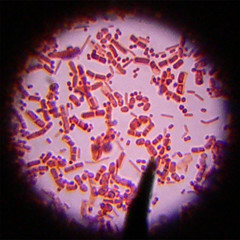Taxonomy Flashcards
Terms : Hide Images [1]
| 10536096291 | Taxonomy | A scientific discipline concerned with naming and classifying the diverse forms of life |  | 0 |
| 10536096292 | Kingdom | A taxonomic category, the second broadest after domain. |  | 1 |
| 10536096293 | Protista | Kingdom composed of eukaryotes that are not classified as plants, animals, or fungi |  | 2 |
| 10536096294 | Archaebacteria | Ancient prokaryotes that survive in extreme anaerobic conditions, such as deap sea vents and extreme salinity. |  | 3 |
| 10536096295 | Eubacteria | A kingdom that contains all prokaryotes except archaebacteria |  | 4 |
| 10536096296 | Binomial nomenclature | two word naming system devised by Linnaeus | 5 | |
| 10536096297 | Classification | grouping of organisms for practical purposes | 6 | |
| 10536096298 | Latin | language used for scientific naming | 7 | |
| 10536096299 | Order | a group of related families | 8 | |
| 10536096300 | Kingdom | group of related phyla | 9 | |
| 10536096301 | Species | a group that can successfully reproduce and is the smallest classification in the taxonomic hierarchy | 10 | |
| 10536096302 | Genus | group of related species | 11 | |
| 10536096303 | Division | takes the place of p"Phylum" category for plants | 12 | |
| 10536096304 | Fungus | heterotrophic eukaryote associated with decomposition most multicellular but yeast | 13 | |
| 10536096305 | Prokaryote | unicellular and lack membrane-bound organelles | 14 | |
| 10536096306 | Plantae | multicellular, eukaryotic, autotrophs | 15 | |
| 10536096307 | Animalia | multicellular, eukaryote, heterotroph that lack cell walls | 16 | |
| 10536096308 | Moneran- bacteria | unicellular, auto and heterotroph, prokaryote | 17 | |
| 10536096309 | Protista | unicellular and colonial, auto and heterotroph, maybe has cell walls | 18 | |
| 10536096310 | Taxonomy order | Domain, Kingdom, Phylum(or Division), Class, Order, Family, genus species | 19 | |
| 10536096311 | Aristotle | created the first taxonomic system | 20 | |
| 10536096312 | Chitin | major cell-wall material of Fungi | 21 | |
| 10536096313 | Peptidoglycan or Glycoprotein | major cell-wall material for Bacteria | 22 | |
| 10536096314 | Coleoptera | Beetle order | 23 | |
| 10536096315 | Ephemeroptera | Mayfly order | 24 | |
| 10536096316 | Diptera | Housefly order | 25 | |
| 10536096317 | Odonata | Damselfly order | 26 | |
| 10536096318 | Saltatorial legs | used for jumping | 27 | |
| 10536096319 | Natatorial legs | used for swimming | 28 | |
| 10536096320 | Scansorial legs | hook onto hair or feathers | 29 | |
| 10536096321 | Raptorial legs | used to grasp prey | 30 | |
| 10536096322 | Cursorial legs | used to walk or run | 31 | |
| 10536096323 | Thysanura | Silverfish and firebrat order | 32 | |
| 10536096324 | Lepidoptera | Skipper and Luna Moth order | 33 | |
| 10536096325 | Linnaeus | creator of our modern taxonomic system | 34 | |
| 10536096326 | Elytra | cover wings of beetles | 35 | |
| 10536096327 | Hemilytra | wing structure found on a stink or boxelder bug | 36 | |
| 10536096328 | Holometabolistic metamorphosis | A type of complete metamorphosis where an insect goes through the stages of egg, larvae, pupae, to adult | 37 | |
| 10536096329 | Gradual or Incomplete | Metamorphosis where insects progress through egg, intermediate stage, then the adult (no drastic change in form) | 38 | |
| 10536096330 | Nymph | terrestrial intermediate insect | 39 | |
| 10536096331 | Naiad | aquatic intermediate insect | 40 | |
| 10536096332 | Parasitism | living together where only one organism benefits | 41 | |
| 10536096333 | Symbiosis | living arrangement where 2 organisms benefit mutually | 42 | |
| 10536096334 | Ametabolistic | lack of any drastic change of an insect from birth to death. Usually primitive insects | 43 | |
| 10536096335 | Hymenoptera | Ant order | 44 | |
| 10536096336 | Geniculate | Ant antennae | 45 | |
| 10536096337 | Aristate | fly antennae | 46 | |
| 10536096338 | Moniliform | cricket antennae | 47 | |
| 10536096339 | setaceous | dragonfly antennae | 48 | |
| 10536096340 | Pectinate or Bipectinate | moth antennae | 49 |
